Climate Change & Fracking Controversy
VerifiedAdded on 2020/04/13
|12
|3251
|35
AI Summary
This assignment delves into the complex relationship between climate change and the controversial practice of fracking. It examines the outcomes of the COP21 Paris Agreement, focusing on its goals for reducing greenhouse gas emissions and its potential impact on fossil fuel extraction methods like fracking. The analysis also explores the ethical considerations surrounding fracking in light of the global effort to combat climate change.
Contribute Materials
Your contribution can guide someone’s learning journey. Share your
documents today.
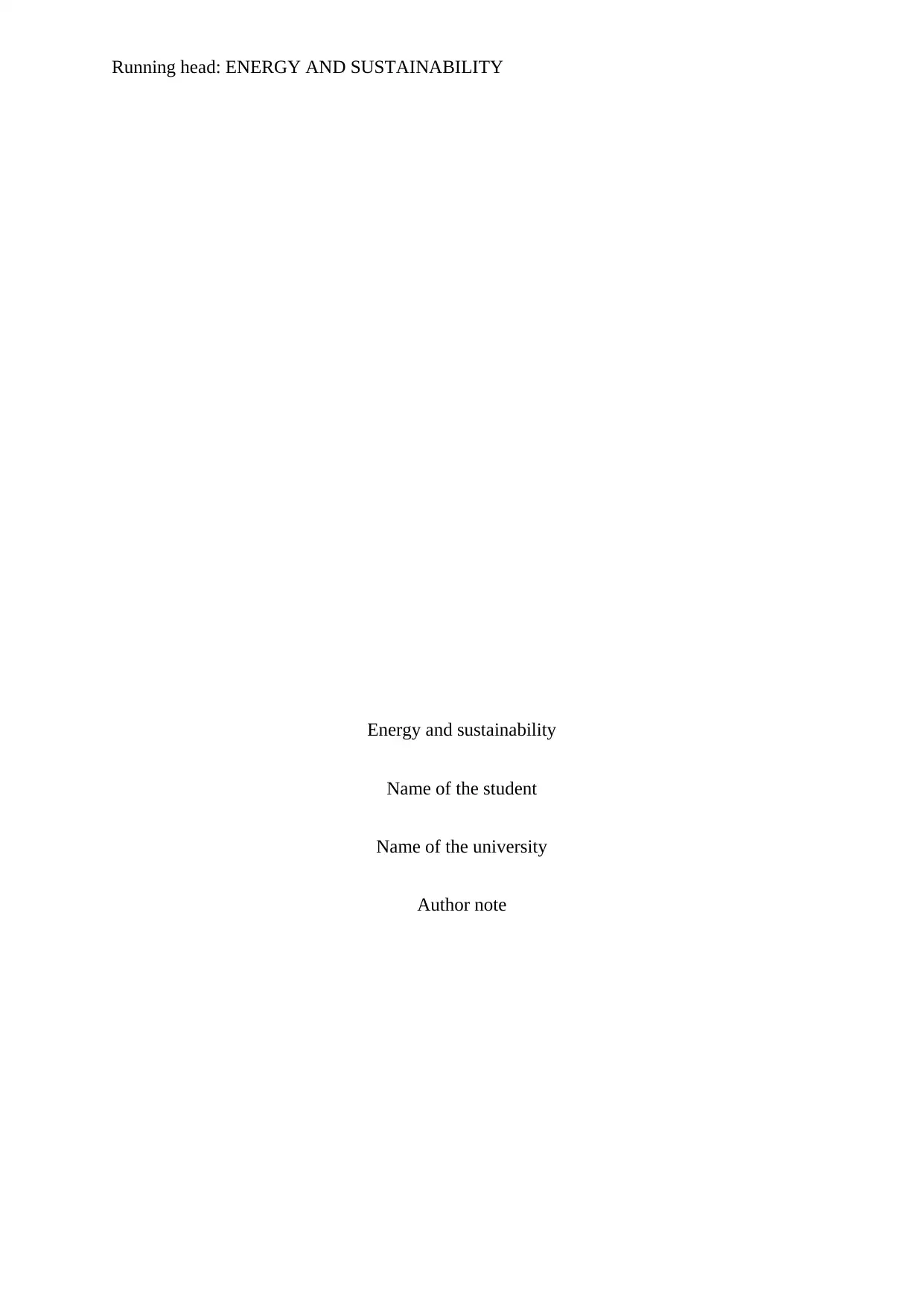
Running head: ENERGY AND SUSTAINABILITY
Energy and sustainability
Name of the student
Name of the university
Author note
Energy and sustainability
Name of the student
Name of the university
Author note
Secure Best Marks with AI Grader
Need help grading? Try our AI Grader for instant feedback on your assignments.
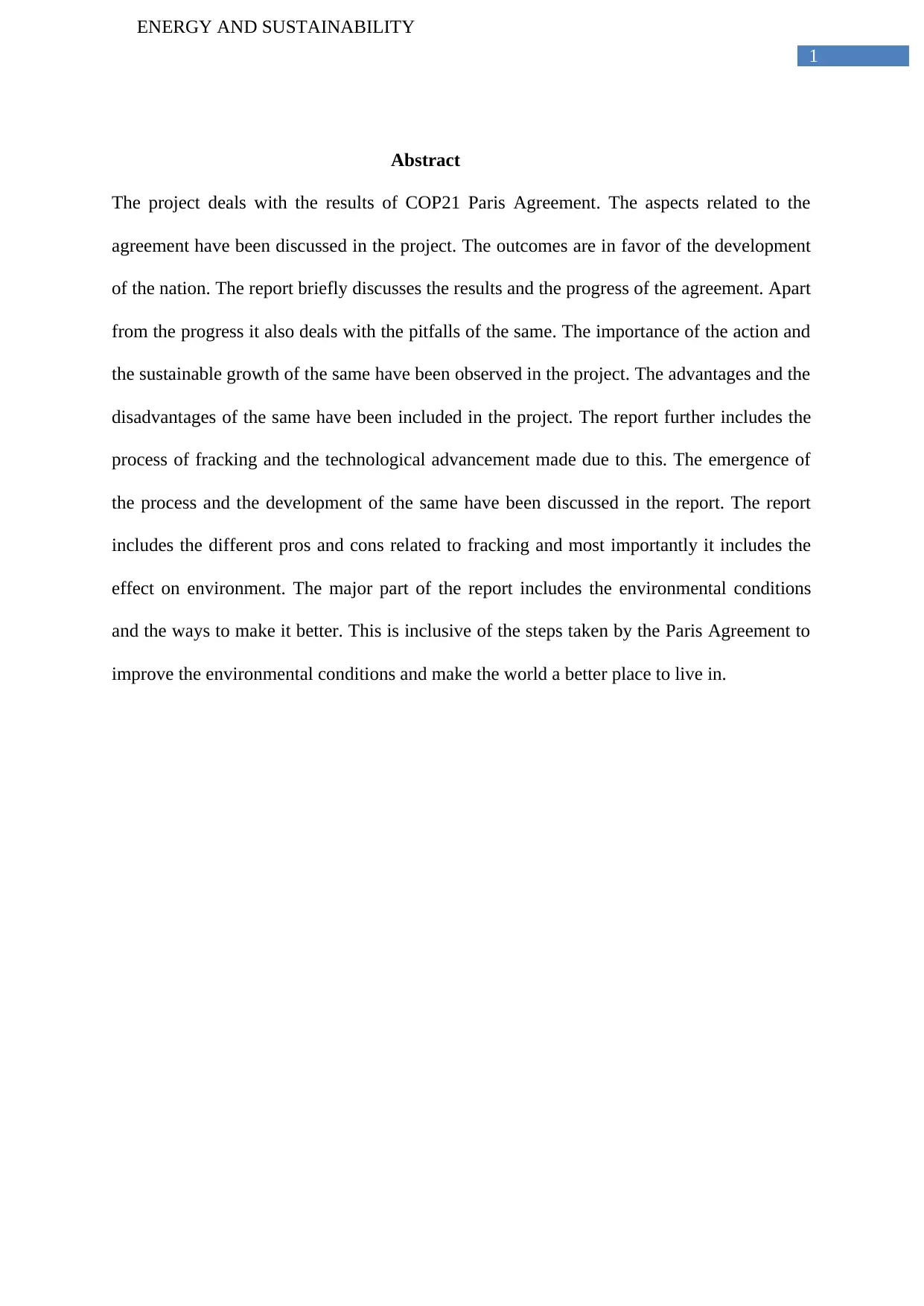
1
ENERGY AND SUSTAINABILITY
Abstract
The project deals with the results of COP21 Paris Agreement. The aspects related to the
agreement have been discussed in the project. The outcomes are in favor of the development
of the nation. The report briefly discusses the results and the progress of the agreement. Apart
from the progress it also deals with the pitfalls of the same. The importance of the action and
the sustainable growth of the same have been observed in the project. The advantages and the
disadvantages of the same have been included in the project. The report further includes the
process of fracking and the technological advancement made due to this. The emergence of
the process and the development of the same have been discussed in the report. The report
includes the different pros and cons related to fracking and most importantly it includes the
effect on environment. The major part of the report includes the environmental conditions
and the ways to make it better. This is inclusive of the steps taken by the Paris Agreement to
improve the environmental conditions and make the world a better place to live in.
ENERGY AND SUSTAINABILITY
Abstract
The project deals with the results of COP21 Paris Agreement. The aspects related to the
agreement have been discussed in the project. The outcomes are in favor of the development
of the nation. The report briefly discusses the results and the progress of the agreement. Apart
from the progress it also deals with the pitfalls of the same. The importance of the action and
the sustainable growth of the same have been observed in the project. The advantages and the
disadvantages of the same have been included in the project. The report further includes the
process of fracking and the technological advancement made due to this. The emergence of
the process and the development of the same have been discussed in the report. The report
includes the different pros and cons related to fracking and most importantly it includes the
effect on environment. The major part of the report includes the environmental conditions
and the ways to make it better. This is inclusive of the steps taken by the Paris Agreement to
improve the environmental conditions and make the world a better place to live in.
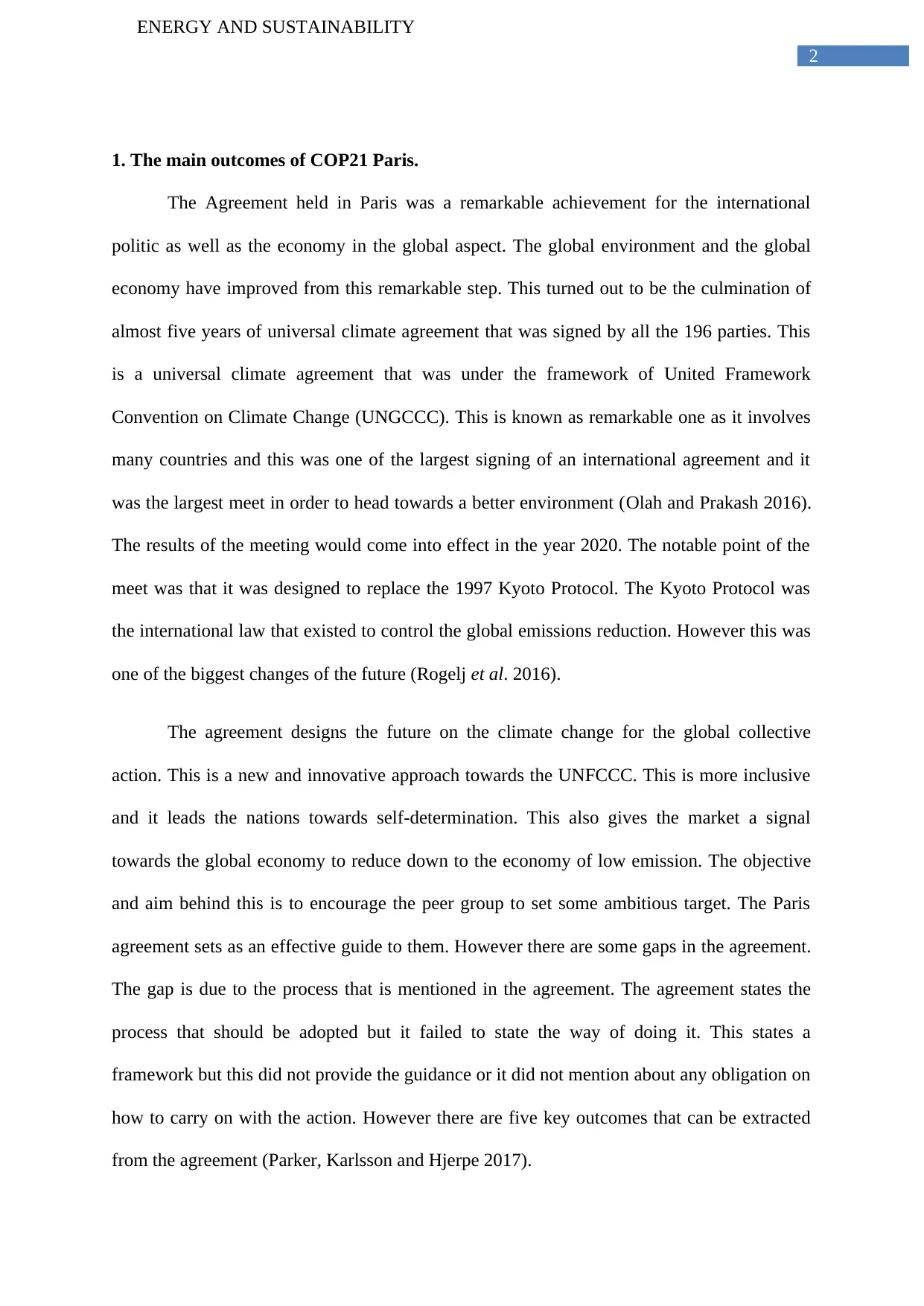
2
ENERGY AND SUSTAINABILITY
1. The main outcomes of COP21 Paris.
The Agreement held in Paris was a remarkable achievement for the international
politic as well as the economy in the global aspect. The global environment and the global
economy have improved from this remarkable step. This turned out to be the culmination of
almost five years of universal climate agreement that was signed by all the 196 parties. This
is a universal climate agreement that was under the framework of United Framework
Convention on Climate Change (UNGCCC). This is known as remarkable one as it involves
many countries and this was one of the largest signing of an international agreement and it
was the largest meet in order to head towards a better environment (Olah and Prakash 2016).
The results of the meeting would come into effect in the year 2020. The notable point of the
meet was that it was designed to replace the 1997 Kyoto Protocol. The Kyoto Protocol was
the international law that existed to control the global emissions reduction. However this was
one of the biggest changes of the future (Rogelj et al. 2016).
The agreement designs the future on the climate change for the global collective
action. This is a new and innovative approach towards the UNFCCC. This is more inclusive
and it leads the nations towards self-determination. This also gives the market a signal
towards the global economy to reduce down to the economy of low emission. The objective
and aim behind this is to encourage the peer group to set some ambitious target. The Paris
agreement sets as an effective guide to them. However there are some gaps in the agreement.
The gap is due to the process that is mentioned in the agreement. The agreement states the
process that should be adopted but it failed to state the way of doing it. This states a
framework but this did not provide the guidance or it did not mention about any obligation on
how to carry on with the action. However there are five key outcomes that can be extracted
from the agreement (Parker, Karlsson and Hjerpe 2017).
ENERGY AND SUSTAINABILITY
1. The main outcomes of COP21 Paris.
The Agreement held in Paris was a remarkable achievement for the international
politic as well as the economy in the global aspect. The global environment and the global
economy have improved from this remarkable step. This turned out to be the culmination of
almost five years of universal climate agreement that was signed by all the 196 parties. This
is a universal climate agreement that was under the framework of United Framework
Convention on Climate Change (UNGCCC). This is known as remarkable one as it involves
many countries and this was one of the largest signing of an international agreement and it
was the largest meet in order to head towards a better environment (Olah and Prakash 2016).
The results of the meeting would come into effect in the year 2020. The notable point of the
meet was that it was designed to replace the 1997 Kyoto Protocol. The Kyoto Protocol was
the international law that existed to control the global emissions reduction. However this was
one of the biggest changes of the future (Rogelj et al. 2016).
The agreement designs the future on the climate change for the global collective
action. This is a new and innovative approach towards the UNFCCC. This is more inclusive
and it leads the nations towards self-determination. This also gives the market a signal
towards the global economy to reduce down to the economy of low emission. The objective
and aim behind this is to encourage the peer group to set some ambitious target. The Paris
agreement sets as an effective guide to them. However there are some gaps in the agreement.
The gap is due to the process that is mentioned in the agreement. The agreement states the
process that should be adopted but it failed to state the way of doing it. This states a
framework but this did not provide the guidance or it did not mention about any obligation on
how to carry on with the action. However there are five key outcomes that can be extracted
from the agreement (Parker, Karlsson and Hjerpe 2017).

3
ENERGY AND SUSTAINABILITY
The first and foremost outcome is the direction for the future. The individuals are
motivated to set commitments. This is intended towards setting a long term goal. The aim of
the agreement is to reduce the temperature that is caused due to Global Warming aiming to
have it within 1.5 degree Celsius (Northrop and Ross 2016).
The other goal is the regular review that keeps a track of the progress and it aims at
the progression of the commitments. A system of review was introduced that is found to
stanch by a five years cycle. This review intends the parties to revise the targets set by them
and it determines the contribution made by them. This step ensures the highest amount of
contribution made by them. The sole intention of this is to keep a track of the progress
(Mazur 2016).
The other outcome is the self-differentiation. The Paris Agreement tries to be more
flexible than the Kyoto Protocol (Robbins 2016). A variability of the developed countries and
the developing countries is the intention of the agreement. The developing nations are
expected to be more responsible over time (Mace and Verheyen 2016). This also promotes
the collective action. All the countries are expected to submit NCDs and they are expected to
adhere to the earlier mentioned requirements of reporting and the compliance of the same.
The framework can help all the countries to head towards the attainment of the same
requirements. This often leads them to the sharing of the technical knowledge. This acts as a
bridge between the developed countries and the developing countries. The transparency of
the framework will ensure the feasibility of the political factors (Koehl and Hess 2016).
The interaction of the factors like lucidity and fulfillment of the articles ingrained the
accountability of the agreement. This encourages competition and cooperation between the
developed and the developing nations. This also includes the recognition of the UNFCC
principle of the common as well as the differentiated responsibility. All the parties must
ENERGY AND SUSTAINABILITY
The first and foremost outcome is the direction for the future. The individuals are
motivated to set commitments. This is intended towards setting a long term goal. The aim of
the agreement is to reduce the temperature that is caused due to Global Warming aiming to
have it within 1.5 degree Celsius (Northrop and Ross 2016).
The other goal is the regular review that keeps a track of the progress and it aims at
the progression of the commitments. A system of review was introduced that is found to
stanch by a five years cycle. This review intends the parties to revise the targets set by them
and it determines the contribution made by them. This step ensures the highest amount of
contribution made by them. The sole intention of this is to keep a track of the progress
(Mazur 2016).
The other outcome is the self-differentiation. The Paris Agreement tries to be more
flexible than the Kyoto Protocol (Robbins 2016). A variability of the developed countries and
the developing countries is the intention of the agreement. The developing nations are
expected to be more responsible over time (Mace and Verheyen 2016). This also promotes
the collective action. All the countries are expected to submit NCDs and they are expected to
adhere to the earlier mentioned requirements of reporting and the compliance of the same.
The framework can help all the countries to head towards the attainment of the same
requirements. This often leads them to the sharing of the technical knowledge. This acts as a
bridge between the developed countries and the developing countries. The transparency of
the framework will ensure the feasibility of the political factors (Koehl and Hess 2016).
The interaction of the factors like lucidity and fulfillment of the articles ingrained the
accountability of the agreement. This encourages competition and cooperation between the
developed and the developing nations. This also includes the recognition of the UNFCC
principle of the common as well as the differentiated responsibility. All the parties must
Secure Best Marks with AI Grader
Need help grading? Try our AI Grader for instant feedback on your assignments.
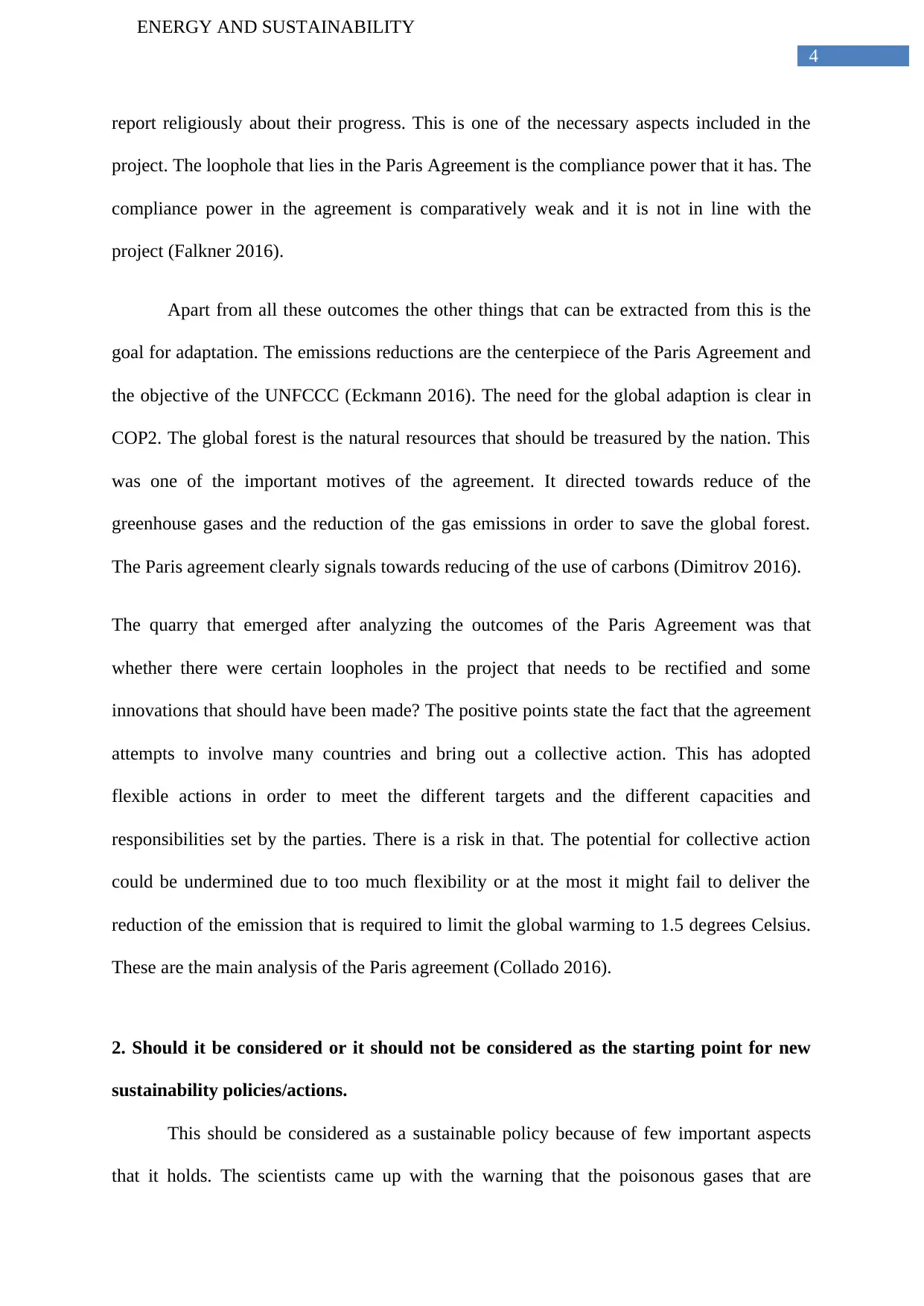
4
ENERGY AND SUSTAINABILITY
report religiously about their progress. This is one of the necessary aspects included in the
project. The loophole that lies in the Paris Agreement is the compliance power that it has. The
compliance power in the agreement is comparatively weak and it is not in line with the
project (Falkner 2016).
Apart from all these outcomes the other things that can be extracted from this is the
goal for adaptation. The emissions reductions are the centerpiece of the Paris Agreement and
the objective of the UNFCCC (Eckmann 2016). The need for the global adaption is clear in
COP2. The global forest is the natural resources that should be treasured by the nation. This
was one of the important motives of the agreement. It directed towards reduce of the
greenhouse gases and the reduction of the gas emissions in order to save the global forest.
The Paris agreement clearly signals towards reducing of the use of carbons (Dimitrov 2016).
The quarry that emerged after analyzing the outcomes of the Paris Agreement was that
whether there were certain loopholes in the project that needs to be rectified and some
innovations that should have been made? The positive points state the fact that the agreement
attempts to involve many countries and bring out a collective action. This has adopted
flexible actions in order to meet the different targets and the different capacities and
responsibilities set by the parties. There is a risk in that. The potential for collective action
could be undermined due to too much flexibility or at the most it might fail to deliver the
reduction of the emission that is required to limit the global warming to 1.5 degrees Celsius.
These are the main analysis of the Paris agreement (Collado 2016).
2. Should it be considered or it should not be considered as the starting point for new
sustainability policies/actions.
This should be considered as a sustainable policy because of few important aspects
that it holds. The scientists came up with the warning that the poisonous gases that are
ENERGY AND SUSTAINABILITY
report religiously about their progress. This is one of the necessary aspects included in the
project. The loophole that lies in the Paris Agreement is the compliance power that it has. The
compliance power in the agreement is comparatively weak and it is not in line with the
project (Falkner 2016).
Apart from all these outcomes the other things that can be extracted from this is the
goal for adaptation. The emissions reductions are the centerpiece of the Paris Agreement and
the objective of the UNFCCC (Eckmann 2016). The need for the global adaption is clear in
COP2. The global forest is the natural resources that should be treasured by the nation. This
was one of the important motives of the agreement. It directed towards reduce of the
greenhouse gases and the reduction of the gas emissions in order to save the global forest.
The Paris agreement clearly signals towards reducing of the use of carbons (Dimitrov 2016).
The quarry that emerged after analyzing the outcomes of the Paris Agreement was that
whether there were certain loopholes in the project that needs to be rectified and some
innovations that should have been made? The positive points state the fact that the agreement
attempts to involve many countries and bring out a collective action. This has adopted
flexible actions in order to meet the different targets and the different capacities and
responsibilities set by the parties. There is a risk in that. The potential for collective action
could be undermined due to too much flexibility or at the most it might fail to deliver the
reduction of the emission that is required to limit the global warming to 1.5 degrees Celsius.
These are the main analysis of the Paris agreement (Collado 2016).
2. Should it be considered or it should not be considered as the starting point for new
sustainability policies/actions.
This should be considered as a sustainable policy because of few important aspects
that it holds. The scientists came up with the warning that the poisonous gases that are
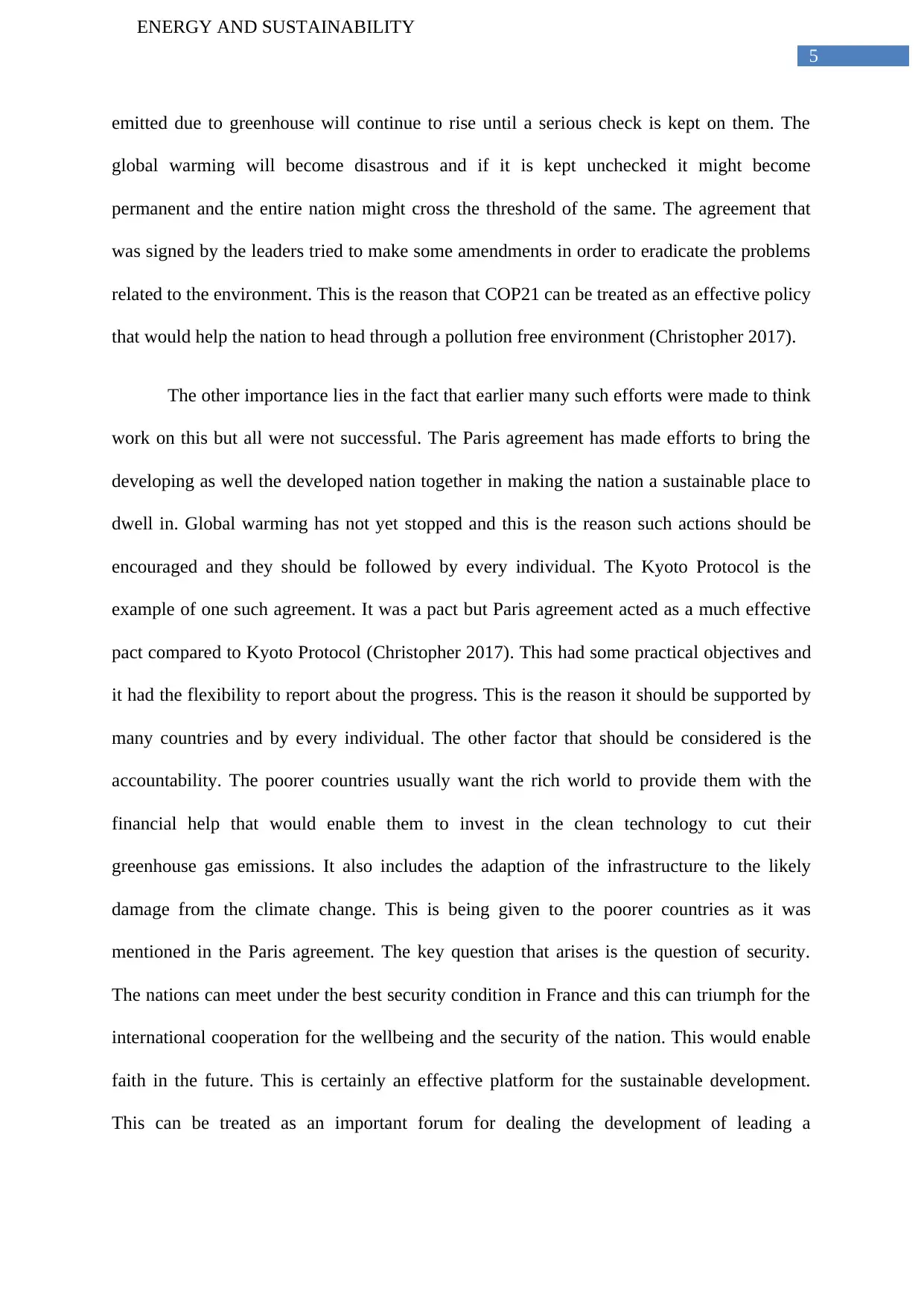
5
ENERGY AND SUSTAINABILITY
emitted due to greenhouse will continue to rise until a serious check is kept on them. The
global warming will become disastrous and if it is kept unchecked it might become
permanent and the entire nation might cross the threshold of the same. The agreement that
was signed by the leaders tried to make some amendments in order to eradicate the problems
related to the environment. This is the reason that COP21 can be treated as an effective policy
that would help the nation to head through a pollution free environment (Christopher 2017).
The other importance lies in the fact that earlier many such efforts were made to think
work on this but all were not successful. The Paris agreement has made efforts to bring the
developing as well the developed nation together in making the nation a sustainable place to
dwell in. Global warming has not yet stopped and this is the reason such actions should be
encouraged and they should be followed by every individual. The Kyoto Protocol is the
example of one such agreement. It was a pact but Paris agreement acted as a much effective
pact compared to Kyoto Protocol (Christopher 2017). This had some practical objectives and
it had the flexibility to report about the progress. This is the reason it should be supported by
many countries and by every individual. The other factor that should be considered is the
accountability. The poorer countries usually want the rich world to provide them with the
financial help that would enable them to invest in the clean technology to cut their
greenhouse gas emissions. It also includes the adaption of the infrastructure to the likely
damage from the climate change. This is being given to the poorer countries as it was
mentioned in the Paris agreement. The key question that arises is the question of security.
The nations can meet under the best security condition in France and this can triumph for the
international cooperation for the wellbeing and the security of the nation. This would enable
faith in the future. This is certainly an effective platform for the sustainable development.
This can be treated as an important forum for dealing the development of leading a
ENERGY AND SUSTAINABILITY
emitted due to greenhouse will continue to rise until a serious check is kept on them. The
global warming will become disastrous and if it is kept unchecked it might become
permanent and the entire nation might cross the threshold of the same. The agreement that
was signed by the leaders tried to make some amendments in order to eradicate the problems
related to the environment. This is the reason that COP21 can be treated as an effective policy
that would help the nation to head through a pollution free environment (Christopher 2017).
The other importance lies in the fact that earlier many such efforts were made to think
work on this but all were not successful. The Paris agreement has made efforts to bring the
developing as well the developed nation together in making the nation a sustainable place to
dwell in. Global warming has not yet stopped and this is the reason such actions should be
encouraged and they should be followed by every individual. The Kyoto Protocol is the
example of one such agreement. It was a pact but Paris agreement acted as a much effective
pact compared to Kyoto Protocol (Christopher 2017). This had some practical objectives and
it had the flexibility to report about the progress. This is the reason it should be supported by
many countries and by every individual. The other factor that should be considered is the
accountability. The poorer countries usually want the rich world to provide them with the
financial help that would enable them to invest in the clean technology to cut their
greenhouse gas emissions. It also includes the adaption of the infrastructure to the likely
damage from the climate change. This is being given to the poorer countries as it was
mentioned in the Paris agreement. The key question that arises is the question of security.
The nations can meet under the best security condition in France and this can triumph for the
international cooperation for the wellbeing and the security of the nation. This would enable
faith in the future. This is certainly an effective platform for the sustainable development.
This can be treated as an important forum for dealing the development of leading a
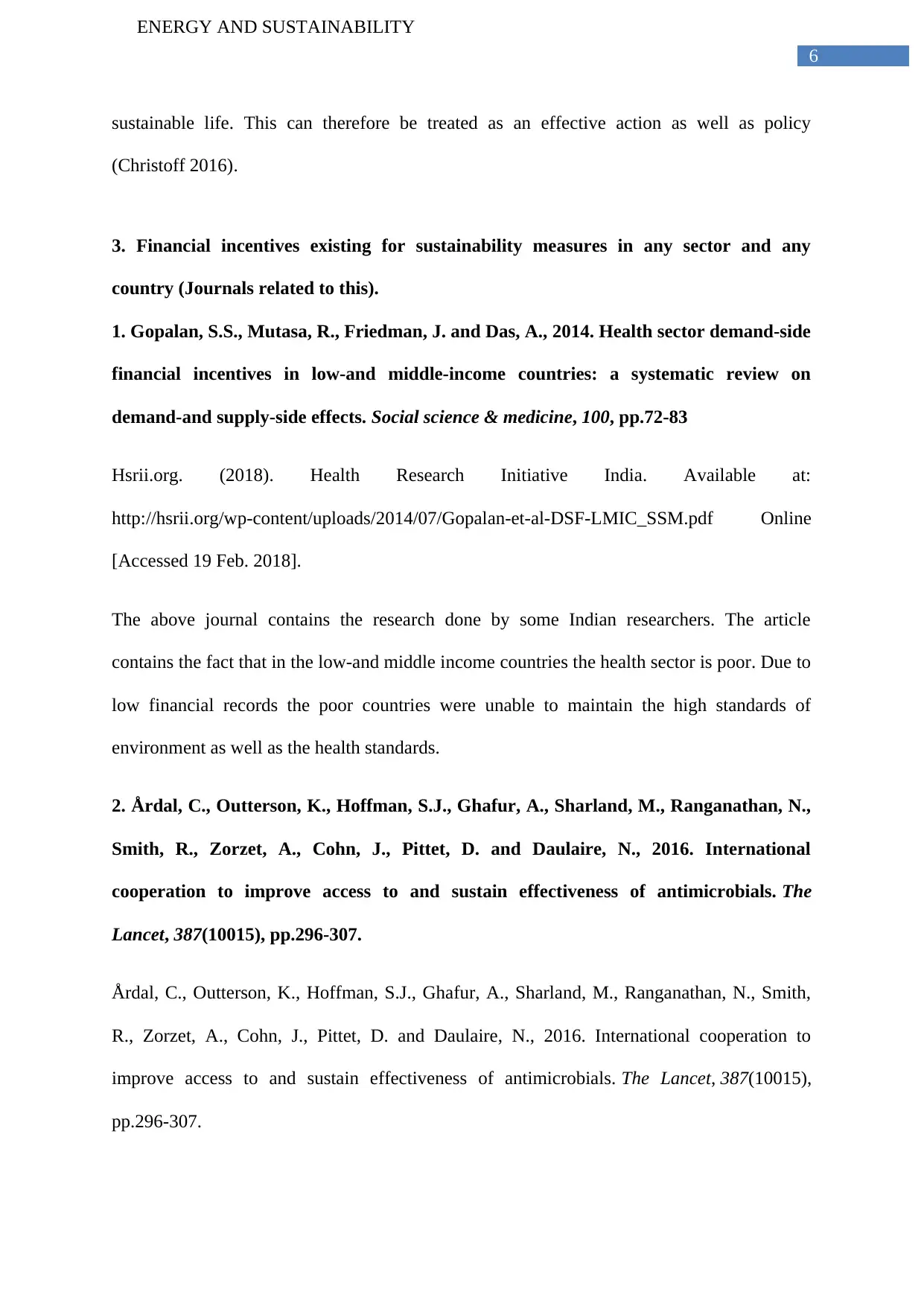
6
ENERGY AND SUSTAINABILITY
sustainable life. This can therefore be treated as an effective action as well as policy
(Christoff 2016).
3. Financial incentives existing for sustainability measures in any sector and any
country (Journals related to this).
1. Gopalan, S.S., Mutasa, R., Friedman, J. and Das, A., 2014. Health sector demand-side
financial incentives in low-and middle-income countries: a systematic review on
demand-and supply-side effects. Social science & medicine, 100, pp.72-83
Hsrii.org. (2018). Health Research Initiative India. Available at:
http://hsrii.org/wp-content/uploads/2014/07/Gopalan-et-al-DSF-LMIC_SSM.pdf Online
[Accessed 19 Feb. 2018].
The above journal contains the research done by some Indian researchers. The article
contains the fact that in the low-and middle income countries the health sector is poor. Due to
low financial records the poor countries were unable to maintain the high standards of
environment as well as the health standards.
2. Årdal, C., Outterson, K., Hoffman, S.J., Ghafur, A., Sharland, M., Ranganathan, N.,
Smith, R., Zorzet, A., Cohn, J., Pittet, D. and Daulaire, N., 2016. International
cooperation to improve access to and sustain effectiveness of antimicrobials. The
Lancet, 387(10015), pp.296-307.
Årdal, C., Outterson, K., Hoffman, S.J., Ghafur, A., Sharland, M., Ranganathan, N., Smith,
R., Zorzet, A., Cohn, J., Pittet, D. and Daulaire, N., 2016. International cooperation to
improve access to and sustain effectiveness of antimicrobials. The Lancet, 387(10015),
pp.296-307.
ENERGY AND SUSTAINABILITY
sustainable life. This can therefore be treated as an effective action as well as policy
(Christoff 2016).
3. Financial incentives existing for sustainability measures in any sector and any
country (Journals related to this).
1. Gopalan, S.S., Mutasa, R., Friedman, J. and Das, A., 2014. Health sector demand-side
financial incentives in low-and middle-income countries: a systematic review on
demand-and supply-side effects. Social science & medicine, 100, pp.72-83
Hsrii.org. (2018). Health Research Initiative India. Available at:
http://hsrii.org/wp-content/uploads/2014/07/Gopalan-et-al-DSF-LMIC_SSM.pdf Online
[Accessed 19 Feb. 2018].
The above journal contains the research done by some Indian researchers. The article
contains the fact that in the low-and middle income countries the health sector is poor. Due to
low financial records the poor countries were unable to maintain the high standards of
environment as well as the health standards.
2. Årdal, C., Outterson, K., Hoffman, S.J., Ghafur, A., Sharland, M., Ranganathan, N.,
Smith, R., Zorzet, A., Cohn, J., Pittet, D. and Daulaire, N., 2016. International
cooperation to improve access to and sustain effectiveness of antimicrobials. The
Lancet, 387(10015), pp.296-307.
Årdal, C., Outterson, K., Hoffman, S.J., Ghafur, A., Sharland, M., Ranganathan, N., Smith,
R., Zorzet, A., Cohn, J., Pittet, D. and Daulaire, N., 2016. International cooperation to
improve access to and sustain effectiveness of antimicrobials. The Lancet, 387(10015),
pp.296-307.
Paraphrase This Document
Need a fresh take? Get an instant paraphrase of this document with our AI Paraphraser
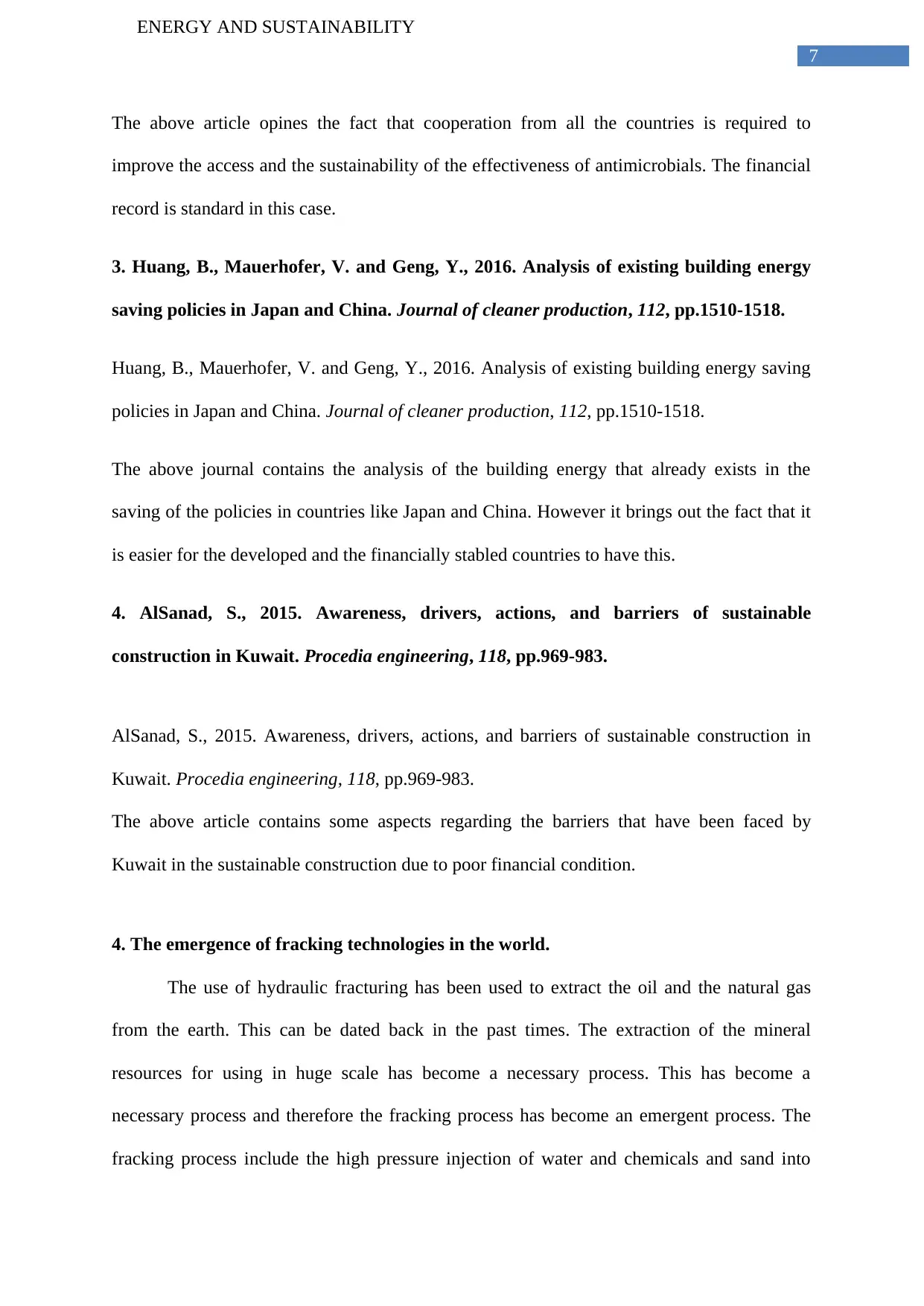
7
ENERGY AND SUSTAINABILITY
The above article opines the fact that cooperation from all the countries is required to
improve the access and the sustainability of the effectiveness of antimicrobials. The financial
record is standard in this case.
3. Huang, B., Mauerhofer, V. and Geng, Y., 2016. Analysis of existing building energy
saving policies in Japan and China. Journal of cleaner production, 112, pp.1510-1518.
Huang, B., Mauerhofer, V. and Geng, Y., 2016. Analysis of existing building energy saving
policies in Japan and China. Journal of cleaner production, 112, pp.1510-1518.
The above journal contains the analysis of the building energy that already exists in the
saving of the policies in countries like Japan and China. However it brings out the fact that it
is easier for the developed and the financially stabled countries to have this.
4. AlSanad, S., 2015. Awareness, drivers, actions, and barriers of sustainable
construction in Kuwait. Procedia engineering, 118, pp.969-983.
AlSanad, S., 2015. Awareness, drivers, actions, and barriers of sustainable construction in
Kuwait. Procedia engineering, 118, pp.969-983.
The above article contains some aspects regarding the barriers that have been faced by
Kuwait in the sustainable construction due to poor financial condition.
4. The emergence of fracking technologies in the world.
The use of hydraulic fracturing has been used to extract the oil and the natural gas
from the earth. This can be dated back in the past times. The extraction of the mineral
resources for using in huge scale has become a necessary process. This has become a
necessary process and therefore the fracking process has become an emergent process. The
fracking process include the high pressure injection of water and chemicals and sand into
ENERGY AND SUSTAINABILITY
The above article opines the fact that cooperation from all the countries is required to
improve the access and the sustainability of the effectiveness of antimicrobials. The financial
record is standard in this case.
3. Huang, B., Mauerhofer, V. and Geng, Y., 2016. Analysis of existing building energy
saving policies in Japan and China. Journal of cleaner production, 112, pp.1510-1518.
Huang, B., Mauerhofer, V. and Geng, Y., 2016. Analysis of existing building energy saving
policies in Japan and China. Journal of cleaner production, 112, pp.1510-1518.
The above journal contains the analysis of the building energy that already exists in the
saving of the policies in countries like Japan and China. However it brings out the fact that it
is easier for the developed and the financially stabled countries to have this.
4. AlSanad, S., 2015. Awareness, drivers, actions, and barriers of sustainable
construction in Kuwait. Procedia engineering, 118, pp.969-983.
AlSanad, S., 2015. Awareness, drivers, actions, and barriers of sustainable construction in
Kuwait. Procedia engineering, 118, pp.969-983.
The above article contains some aspects regarding the barriers that have been faced by
Kuwait in the sustainable construction due to poor financial condition.
4. The emergence of fracking technologies in the world.
The use of hydraulic fracturing has been used to extract the oil and the natural gas
from the earth. This can be dated back in the past times. The extraction of the mineral
resources for using in huge scale has become a necessary process. This has become a
necessary process and therefore the fracking process has become an emergent process. The
fracking process include the high pressure injection of water and chemicals and sand into

8
ENERGY AND SUSTAINABILITY
shale deposits in order to release the gas and oil trapped within the rock in recent years has
been combined with the horizontal drilling and other improvements in technology in order to
harvest stores of gas and oil that previously were thought commercially unfeasible to access.
There are various positive impacts of this process. The countries having more natural
resources can adopt the process of fracking. This would enable the countries that are having
fewer resources to get the resources from the ones who have that in abundance. However
apart from the positive impacts there are some negative impacts that are exist in this process.
It poses high risk to the environment. The quality of air gets affected due to this. This is due
to the engine exhaust from the increased the truck traffic. The gas is burned and it is released
directly into the atmosphere which is harmful for the environment. The faulty equipment
process leads to unintentional emissions of pollutants. This poses a risk to the underwater. It
contaminates the groundwater and also the surface water (Castillo, Fanini and Baker Hughes
2017).
This was however an important requirement in the environment. The emergence of
this process was first seen in the year 1862. It was during the Civil War. The battle of
Fredericksburg was witnessed the process of fracking. Veteran Col. Edward A.L Roberts saw
what could be completed while firing the explosive artillery into a narrow canal that could
obstruct the battlefield. The new sources of energy should be weighed against the
environmental, health and safety concerns that are related to the new technology. While
analyzing the entire process it can be said that the negative aspects are more than the positive
aspects. The extraction of the natural resources is quite important but it certainly leads to air
pollution as it openly exposed to the air that increases the pollution. The extraction of the
natural resources led to the emergence of the process of fracking (Castillo, Fanini and Baker
Hughes 2016).
ENERGY AND SUSTAINABILITY
shale deposits in order to release the gas and oil trapped within the rock in recent years has
been combined with the horizontal drilling and other improvements in technology in order to
harvest stores of gas and oil that previously were thought commercially unfeasible to access.
There are various positive impacts of this process. The countries having more natural
resources can adopt the process of fracking. This would enable the countries that are having
fewer resources to get the resources from the ones who have that in abundance. However
apart from the positive impacts there are some negative impacts that are exist in this process.
It poses high risk to the environment. The quality of air gets affected due to this. This is due
to the engine exhaust from the increased the truck traffic. The gas is burned and it is released
directly into the atmosphere which is harmful for the environment. The faulty equipment
process leads to unintentional emissions of pollutants. This poses a risk to the underwater. It
contaminates the groundwater and also the surface water (Castillo, Fanini and Baker Hughes
2017).
This was however an important requirement in the environment. The emergence of
this process was first seen in the year 1862. It was during the Civil War. The battle of
Fredericksburg was witnessed the process of fracking. Veteran Col. Edward A.L Roberts saw
what could be completed while firing the explosive artillery into a narrow canal that could
obstruct the battlefield. The new sources of energy should be weighed against the
environmental, health and safety concerns that are related to the new technology. While
analyzing the entire process it can be said that the negative aspects are more than the positive
aspects. The extraction of the natural resources is quite important but it certainly leads to air
pollution as it openly exposed to the air that increases the pollution. The extraction of the
natural resources led to the emergence of the process of fracking (Castillo, Fanini and Baker
Hughes 2016).

9
ENERGY AND SUSTAINABILITY
ENERGY AND SUSTAINABILITY
Secure Best Marks with AI Grader
Need help grading? Try our AI Grader for instant feedback on your assignments.
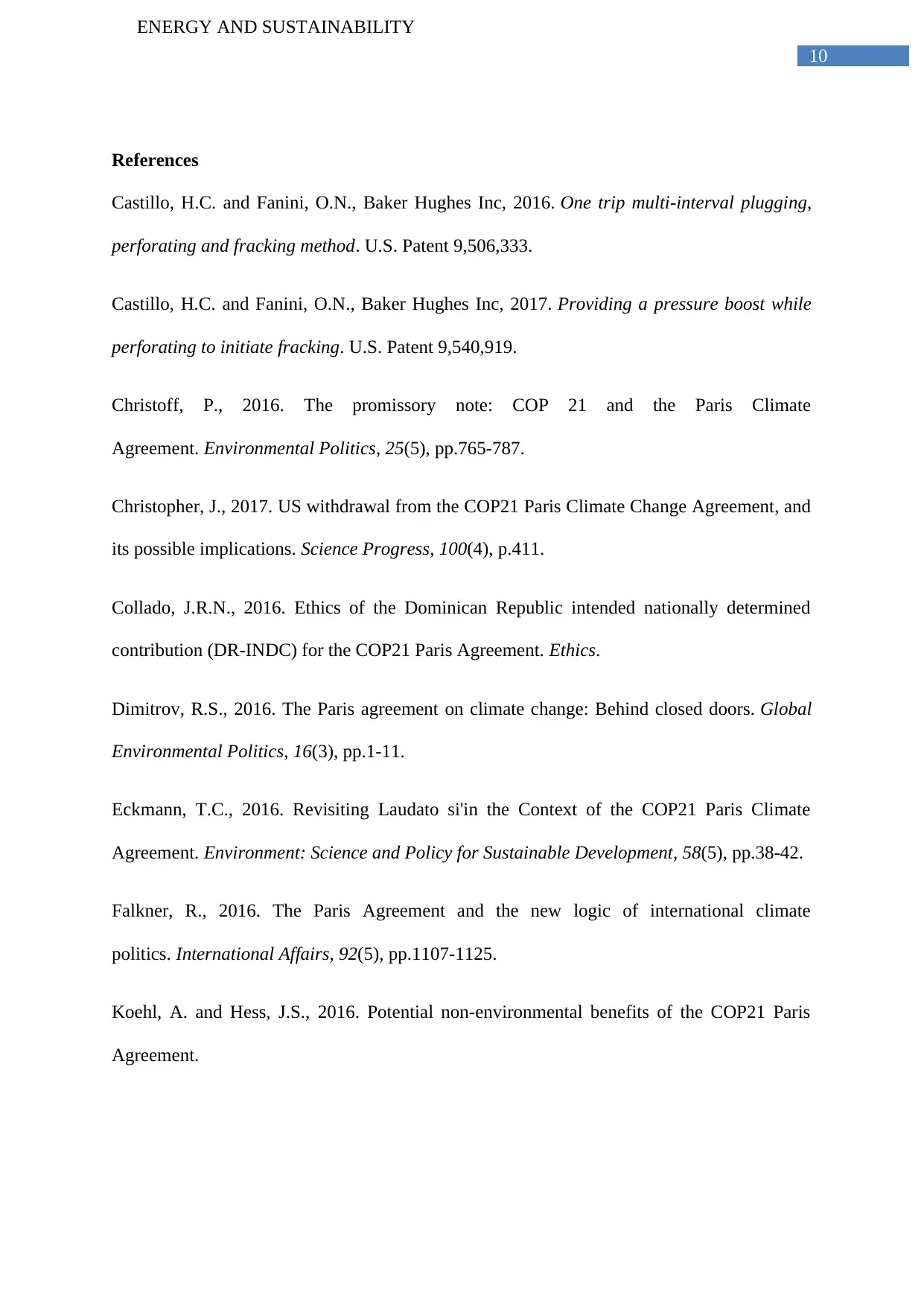
10
ENERGY AND SUSTAINABILITY
References
Castillo, H.C. and Fanini, O.N., Baker Hughes Inc, 2016. One trip multi-interval plugging,
perforating and fracking method. U.S. Patent 9,506,333.
Castillo, H.C. and Fanini, O.N., Baker Hughes Inc, 2017. Providing a pressure boost while
perforating to initiate fracking. U.S. Patent 9,540,919.
Christoff, P., 2016. The promissory note: COP 21 and the Paris Climate
Agreement. Environmental Politics, 25(5), pp.765-787.
Christopher, J., 2017. US withdrawal from the COP21 Paris Climate Change Agreement, and
its possible implications. Science Progress, 100(4), p.411.
Collado, J.R.N., 2016. Ethics of the Dominican Republic intended nationally determined
contribution (DR-INDC) for the COP21 Paris Agreement. Ethics.
Dimitrov, R.S., 2016. The Paris agreement on climate change: Behind closed doors. Global
Environmental Politics, 16(3), pp.1-11.
Eckmann, T.C., 2016. Revisiting Laudato si'in the Context of the COP21 Paris Climate
Agreement. Environment: Science and Policy for Sustainable Development, 58(5), pp.38-42.
Falkner, R., 2016. The Paris Agreement and the new logic of international climate
politics. International Affairs, 92(5), pp.1107-1125.
Koehl, A. and Hess, J.S., 2016. Potential non-environmental benefits of the COP21 Paris
Agreement.
ENERGY AND SUSTAINABILITY
References
Castillo, H.C. and Fanini, O.N., Baker Hughes Inc, 2016. One trip multi-interval plugging,
perforating and fracking method. U.S. Patent 9,506,333.
Castillo, H.C. and Fanini, O.N., Baker Hughes Inc, 2017. Providing a pressure boost while
perforating to initiate fracking. U.S. Patent 9,540,919.
Christoff, P., 2016. The promissory note: COP 21 and the Paris Climate
Agreement. Environmental Politics, 25(5), pp.765-787.
Christopher, J., 2017. US withdrawal from the COP21 Paris Climate Change Agreement, and
its possible implications. Science Progress, 100(4), p.411.
Collado, J.R.N., 2016. Ethics of the Dominican Republic intended nationally determined
contribution (DR-INDC) for the COP21 Paris Agreement. Ethics.
Dimitrov, R.S., 2016. The Paris agreement on climate change: Behind closed doors. Global
Environmental Politics, 16(3), pp.1-11.
Eckmann, T.C., 2016. Revisiting Laudato si'in the Context of the COP21 Paris Climate
Agreement. Environment: Science and Policy for Sustainable Development, 58(5), pp.38-42.
Falkner, R., 2016. The Paris Agreement and the new logic of international climate
politics. International Affairs, 92(5), pp.1107-1125.
Koehl, A. and Hess, J.S., 2016. Potential non-environmental benefits of the COP21 Paris
Agreement.

11
ENERGY AND SUSTAINABILITY
Mace, M.J. and Verheyen, R., 2016. Loss, damage and responsibility after COP21: all
options open for the Paris agreement. Review of European, Comparative & International
Environmental Law, 25(2), pp.197-214.
Mazur, A., 2016. How did the fracking controversy emerge in the period 2010-2012?. Public
Understanding of Science, 25(2), pp.207-222.
Northrop, E. and Ross, K., 2016. After COP21: what needs to happen for the Paris agreement
to take effect?. Geominas, 44(70), pp.133-137.
Olah, G.A. and Prakash, G.S., University of Southern California (USC), 2016. Fracking with
co2 for shale gas reforming to methanol. U.S. Patent Application 15/036,506
Parker, C.F., Karlsson, C. and Hjerpe, M., 2017. Assessing the European Union’s global
climate change leadership: from Copenhagen to the Paris Agreement. Journal of European
Integration, 39(2), pp.239-252.
Robbins, A., 2016. How to understand the results of the climate change summit: Conference
of Parties21 (COP21) Paris 2015.
Rogelj, J., Den Elzen, M., Höhne, N., Fransen, T., Fekete, H., Winkler, H., Schaeffer, R.,
Sha, F., Riahi, K. and Meinshausen, M., 2016. Paris Agreement climate proposals need a
boost to keep warming well below 2 C. Nature, 534(7609), p.631.
ENERGY AND SUSTAINABILITY
Mace, M.J. and Verheyen, R., 2016. Loss, damage and responsibility after COP21: all
options open for the Paris agreement. Review of European, Comparative & International
Environmental Law, 25(2), pp.197-214.
Mazur, A., 2016. How did the fracking controversy emerge in the period 2010-2012?. Public
Understanding of Science, 25(2), pp.207-222.
Northrop, E. and Ross, K., 2016. After COP21: what needs to happen for the Paris agreement
to take effect?. Geominas, 44(70), pp.133-137.
Olah, G.A. and Prakash, G.S., University of Southern California (USC), 2016. Fracking with
co2 for shale gas reforming to methanol. U.S. Patent Application 15/036,506
Parker, C.F., Karlsson, C. and Hjerpe, M., 2017. Assessing the European Union’s global
climate change leadership: from Copenhagen to the Paris Agreement. Journal of European
Integration, 39(2), pp.239-252.
Robbins, A., 2016. How to understand the results of the climate change summit: Conference
of Parties21 (COP21) Paris 2015.
Rogelj, J., Den Elzen, M., Höhne, N., Fransen, T., Fekete, H., Winkler, H., Schaeffer, R.,
Sha, F., Riahi, K. and Meinshausen, M., 2016. Paris Agreement climate proposals need a
boost to keep warming well below 2 C. Nature, 534(7609), p.631.
1 out of 12
Related Documents
Your All-in-One AI-Powered Toolkit for Academic Success.
+13062052269
info@desklib.com
Available 24*7 on WhatsApp / Email
![[object Object]](/_next/static/media/star-bottom.7253800d.svg)
Unlock your academic potential
© 2024 | Zucol Services PVT LTD | All rights reserved.





